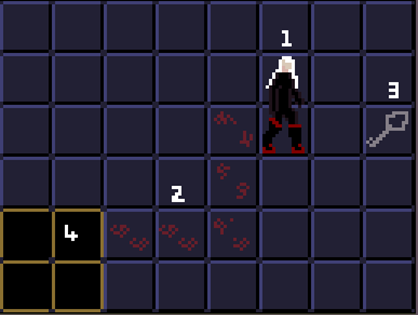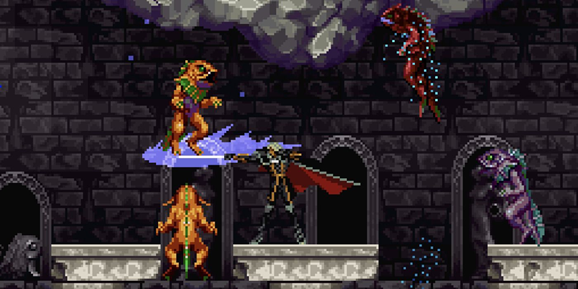Game Concept
Working Title: Death Boots
Concept Statement
Step into the boots of a forsaken fighter on a quest to purge long-conquered castles of evil. This would be simple – if the boots that you hopped in were ordinary, that is. Unfortunately, these boots were made for killing – run for your life and avoid your footsteps at all costs, or else the one facing death could be you.
Genre
Action-Adventure – A broad and popular genre that describes games where the player typically collects and uses items in a quest towards a final goal, such as fighting a boss. The Legend of Zelda (1986) is one of the defining games of this genre and since my game will adopt many of its mechanics such as collecting keys and items in a dungeon, I think this genre is appropriate. I was unable to find a category that neatly addressed the other main aspect of the game – that the player is forced to stay on the move. It isn’t quite the same as an endless runner, but perhaps there could be some category like “Constant Movement” that could be used to describe the core gameplay mechanic.
Concept Creation Process
My concept came about by initially thinking about what kind of game I wanted to make, and then following a stream of consciousness until I ended up with something that genuinely piqued my interest. I wanted to focus on working with Unity’s tilemap system but didn’t want to include any RPG elements, so my starting point was an idea for a puzzle game where a player explores a dungeon and must solve various tile-based puzzles. I considered the kinds of puzzles it could have and my thoughts turned to the Sootopolis Gym puzzle from Pokémon, which I had coded in Java as a project for KIT101 last semester. In this puzzle you must carefully make your way across icy tiles without stepping on any twice, as they crack under your weight and can only withstand a single step.

Figure 1: Pokémon Ruby and Sapphire Sootopolis Gym, the starting inspiration for my game. The image shows how to make it through the Gym without stepping on any tiles twice (Pokémon Database, 2021).
I thought about how I could use this idea and wondered what the playing experience would be like if the whole world followed this principle of never stepping on the same tile twice. That is when I came up with the concept of the “death boots” that imprint a deadly mark upon each tile you step on. I liked this idea but thought that it wouldn’t make much sense if the tile only became dangerous once you stepped off it, so that’s how I came up with my final idea: in addition to only stepping on each tile once, you cannot linger on tiles for too long or the death boots will consume you. I then returned to thinking about which style of game would be the most appropriate for my idea, and in the end I decided I would use the dungeon-exploring mechanics from The Legend of Zelda since I was familiar with them, and they seemed well-suited to work with tilemaps.
Audience and Competitive Analysis
This game is intended for mid – hardcore gamers of either gender, aged between 12 - 40 years old. Because you have to constantly run and make fast decisions, I wouldn’t recommend it for people who are significantly outside this age bracket as they are less likely to react quickly and accurately, and therefore may find the game frustrating.
Regarding genre, I think the game will appeal to anyone who enjoys action-adventure games like The Legend of Zelda, which was a primary source of inspiration. It could also appeal to fans of auto-scrolling games, who enjoy having to stay on the move and responding quickly to a level as it moves onto the screen.
I also wanted to investigate how the game might appeal to its audience in terms of the “twelve gamer motivations” researched by Yee & Ducheneaut (2019), which is essentially like a Myers-Briggs personality system but specifically for gamers.

Figure 2: The twelve gamer motivations – I intend to focus on Excitement and Strategy (Yee & Ducheneaut 2019, pg. 3)
I will put excitement and strategy at the forefront of my game, which I believe creates an interesting and fairly unique juxtaposition of the thrill of running for your life with strategic, careful decision making on how to proceed (which players will get a chance to do when they reach one of the “safe zones” that will be spread across the dungeon). Although focusing on just these two areas could limit the game’s audience a bit, I think that they will yield the most fun for the scope of this project, as it is harder to flesh out other appealing factors like plot and customisation to the point where they’re enjoyable, and adding multiplayer for the social aspect is not a high priority at the moment (though now I’ve said that I’m liking the idea of how hectic it would be if two players were running around trying to avoid each other’s death trails). Ultimately, by executing simple concepts effectively I believe I can offer a game that will provide a fun and challenging experience.
Game Treatment and Concept Art
Gameplay Overview: Fundamentally similar gameplay to the classic The Legend of Zelda (1986): exploring the many rooms of a dungeon, collecting keys and items that open up new areas and possibilities, and locating and defeating a boss at the end. The twist is that backtracking becomes much more difficult because of the death trail that you leave, so whilst moving forward you must simultaneously ensure that you leave yourself a way to return to each room that you move through.
Figure 3 shows a simple concept image I made to illustrate a few parts of the game:

Figure 3: A basic concept image for Death Boots that I made. The player sprite is modified from a character base by MoikMellah (2019). I added numbers to correspond to the descriptions below.
1. Player: The emphasis is on careful, calculated movement. Initially, the player can only move around (in the four cardinal directions), but by collecting items in the dungeon you can gain more abilities, such as the ability to jump over a row of tiles, that will open up your exploration options. I haven’t planned for the player to have any attacks – to defeat enemies you’ll have to use the deadly tiles you create against them.
2. Deadly Trail: Each tile you step on will change appearance and become dangerous after a short delay. I have a few ideas on how to visually represent the dangerous tiles - the image above shows a slightly creepy approach of having footprints resembling blood splatters appear on the tiles. You can trick enemies into stepping on these tiles to destroy them.
3. Items: Keys are the main collectible in the game and will be scattered throughout the dungeon, often far away from locked doors, forcing you stray further into the dungeon and then perilously make your way back while avoiding your own deadly footsteps.
4. Checkpoints: The main point of the game is that you’re running around like a madman, but I understand that this will be draining on the player, so I intend to implement checkpoints quite generously. My idea is that the checkpoints will be big blocks of obsidian which absorb the energy of the boots and are therefore safe to stand still on, giving the player time to breathe and strategize. If the player dies, they’ll return to the last obsidian tile they stood on, and all tiles will be reset to be non-deadly.
Setting: A slightly creepy, gothic-styled dungeon. See the Castlevania screenshot below for a clearer idea of the aesthetic I’d like to capture.

Figure 4: Screenshot of Castlevania: Symphony of The Night, an example of the Gothic aesthetic I’d like the game to have (Jurkovich, 2021).
Difficulty: If I have time, I intend to make two difficulty modes selectable from the title screen, with one being a regular mode where the player has a small amount of health and tiles become deadly quickly, and a more accessible mode where the player has more health and tiles don’t become deadly as quickly.
Enemies: Monsters will roam the dungeon causing trouble. They’re not necessarily designed to kill you, but rather to distract you, get in your way, and cause mistakes in your tile navigation. I intend for there to be a melee kind that chases you, and a ranged attacker that disrupts your path by launching fireballs. With the right movement, you can trap enemies in deadly tiles and destroy them. I plan for the boss to be a big enemy that charges at the player, and to defeat it you must consistently trick it into landing on your deadly tiles.
References
Jurkovich, T (2021), Castlevania: Every 2D Metroidvania Game In The Series, Ranked. The Gamer, https://www.thegamer.com/castlevania-series-every-2d-metroidvania-ranked/
Matthews, V (2018), The Many Different Types of Video Games & Their Subgenres. iD Tech, https://www.idtech.com/blog/different-types-of-video-game-genres
MoikMellah (2019), MV Platformer Female (32x64). OpenGameArt.org, https://opengameart.org/content/mv-platformer-female-32x64
Nintendo (1986), The Legend of Zelda. Nintendo Entertainment System, Nintendo, Japan
Pokémon Database (2021), Pokémon Sootopolis Gym map (Ruby, Sapphire). Pokémon Database, https://pokemondb.net/maps/sootopolis-gym-rs
Yee, N & Ducheneaut, N (2019), Gamer Motivation Model. Quantic Foundry, https://quanticfoundry.com/wp-content/uploads/2019/04/Gamer-Motivation-Model-Reference.pdf
Death Boots
Fast-paced tile puzzle game made for main assignment of Games Fundamentals at UTAS.
| Status | In development |
| Author | estainer |
| Genre | Puzzle |
More posts
- Documentation + User GuideOct 17, 2021
- Polish and UIOct 10, 2021
- Game TestingOct 07, 2021
- Presentation & GraphicsOct 03, 2021
- Enemies, Interaction, PuzzlesSep 27, 2021
- Level BlockingSep 19, 2021
- Player MovementSep 12, 2021
Leave a comment
Log in with itch.io to leave a comment.